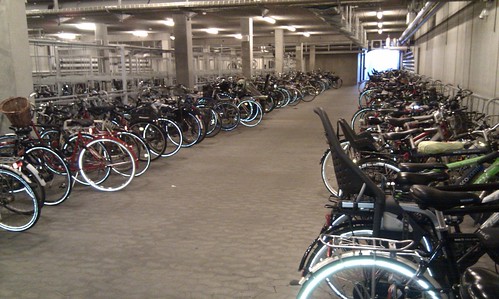Well, Copenhagen has revealed several of my bad habits.
At first glance, it's extremely easy to ride a bike in Copenhagen. There are the famous Copenhagen lanes separating cars from bikes and pedestrians, and the cutest little traffic lights with red, yellow and green bikes to tell you when to go and when to pause. You go to the tourist information or your hotel or the parking authorithy, and you ask for a bicycle map to find all the best biking routes, and you have donned your helmet - preferably, since you're as vain as me, some fashionable version camouflaged as an elegant hat or a fancy cap, or a smooth helmet painted to match your bike or your outfit. After all, biking in the city, you want to look chic.
Now, off you go - and suddenly you discover the Copenhagen bikers' glare. Danes are pretty polite, and tolerant of tourists, but do mind that glare. Did you pause in the wrong side of the lane? There will be a tingling bell - and a glare. Did you forget to signal your slow-down and stop? There's that glare. Did you turn the wrong direction? A muttered "shit" and that glare, again. Slowly, you'll be getting it: you're doing something wrong, and it's time to figure out what before something happens.
First: signals. If you like me learned about traffic safety and biking in school, then you know about using your hands to signal right and left. However, Copenhagen has a third signal: stop. It's used for stopping at the curb, for turning off to the side to wait for the crossing light, for having reached your destination and stopping to park your bike. You lift a hand (optional which) and hold it straight up, either open or as a fist, doesn't matter. And you preferably do it early, or somebody will hit your from behind, and you'll get a lot more than a glare.
Next: attention. At the beginning you're happy to avoid being hit by cars. Then you start congratulating yourself that you don't hit any pedestrians. Then you discover all the bikers glaring at you, and you realise it's time to look out for other bikers. This is when you learn to look before you turn. You see, the lanes are not one-track lanes, but two and sometimes three or four-track lanes. It works just like with cars, slow to the right, faster to the left. Once you have passed your obstacle, you fall in to the right again. Unless you're chatting with your friend at your side. Danes can talk and bike at the same time. Astounding capacity. When you're at that level, you stop caring about the glare, because you're riding with that easy balanced arrogance that comes with knowing you're looking better and getting stronger and more healthy with every turn of the wheel. Yeah, they look good.
Anyway, about that attention. Don't let those good looks distract you. What you're looking for is traffic, and you need to learn how to anticipate it. See that group of people and the bus just pulling in? They will pass through the bike lane in a second. See those tourists messing around, waiting to cross? They don't know about the bike lane, and they will block you. And behind you - catch that faint hum? You're being overtaken, and you need to check for that if you plan to shift out to pass the biker in front of you. And DO mind the red lights. Biking like a maniac to the next light just to have to stop is a waste of energy. Ease up slowly, and hope it shifts to green before you have to stop. It's not like there's always a railing to hang on to. But you're learning.
Soon you'll discover the more subtle signs of Danish biking culture. Like the turned up or tucked in right pant-leg. In the summer half of the year it's mostly turned up, to avoid getting the pants into the chain. That's when you'll notice another little subtle thing: when you wear sandals and your pants are short or tucked up, your ankle tattoo will show! That is, of course, given that you have biked around in Christiania or downtown for long enough to decide you really want a nice little decoration on your right ankle. I have never before seen that many ankle tattoos as I saw this summer, tucked neatly between the shoe and the short or turned-up pants.
Now you're ready for another difficult biking exercize: finding a parking spot. I know people who don't bike in Copenhagen because it's such a hazzle to park. Yeah. But don't despair - despite the many angry glares you'll get if you put your bike in front of shop windows, there are thousands of designated parking spots all over town. And some of them are pretty damn good. Like the ITU basement, which is to a large extent dedicated to parking bicycles.

And yes, my bike is there, today as most days. Sometimes sore, sometimes soaked, sometimes just happy to have gotten here on time - but I live 10 minutes away by bike, and I love it.




No comments:
Post a Comment